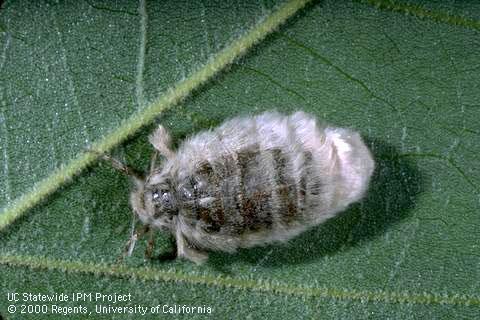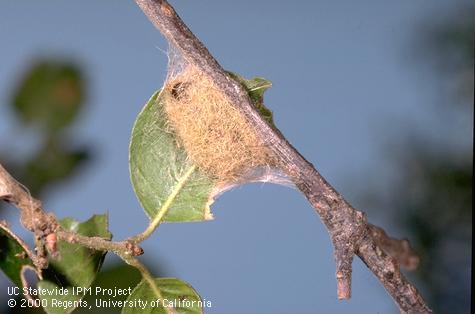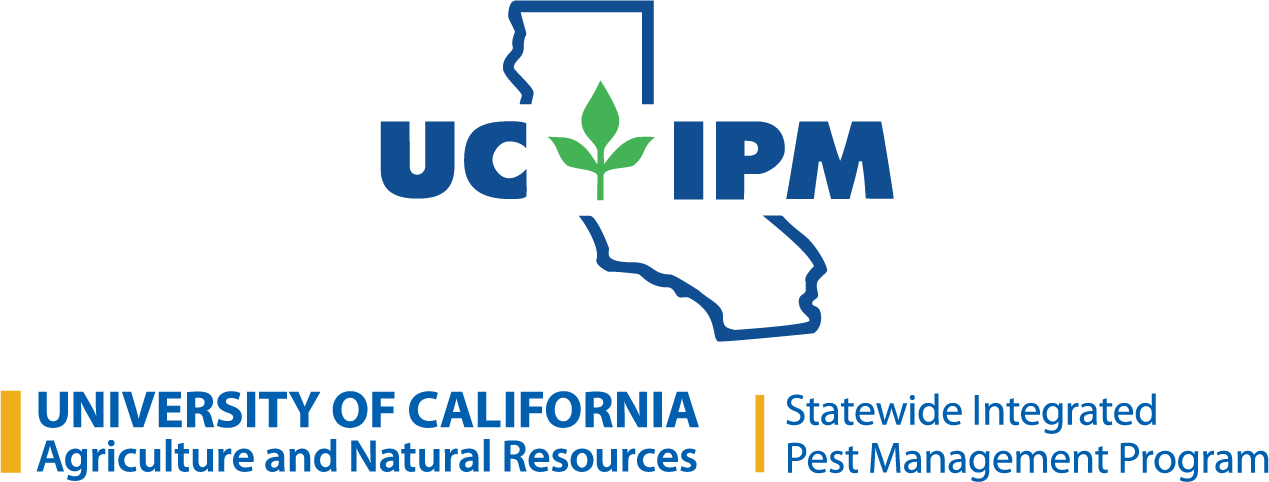Larvae (caterpillars) of tussock moths (Lymantriidae) feed at least occasionally on most any species of deciduous and evergreen trees.

Identification
Adults are hairy and brown, gray, or white moths. Males have a wingspan of about 1-1/2 inches. Females of some species appear to be wingless. The tiny, whitish eggs occur in a mass of several hundred, covered with the female's brownish hairs. A tussock moth egg mass closely resembles the hair-covered pupal case. Pupae occur on or near the host plant.
Young larvae are hairy and black. Full-grown caterpillars have prominent hairs that protrude, some in dense tufts, from colored tubercles along their body.
Western tussock moth, Orgyia vetusta, hosts include fruit and nut trees, hawthorn, manzanita, oak, pyracantha, toyon, walnut, and willow. Mature caterpillars are gray and have numerous bright blue, red, and yellow spots from which gray to white hairs radiate. They have four dense white tufts of hair on the back, two black tufts on the head, and a black and a white tuft at the rear.
Rusty tussock moth, O. antiqua, feeds on many different deciduous and evergreen plants. The adult male is a black, brownish, and gray moth with a whitish blotch and brown band on each forewing. The larvae have a black body with numerous gray to tan hairs. There are three projecting tufts of black hair, two in front and one at the rear, and four orangish to straw-colored tufts along the back.
The Douglas-fir tussock moth, O. pseudotsugata, feeds primarily on Douglas-fir and true firs. Lighter-colored tufts of hair along the back, red spots on top, and an orange stripe along each side distinguish its mature larvae from those of the rusty tussock moth.

Life Cycle
Tussock moths overwinter as eggs. The tiny, dark caterpillars hatch in spring and can use a silk strand and their body hairs to float on the wind to other trees. After feeding, mature larvae pupate on bark in a hairy, brown or tan cocoon. The emerging females produce pheromone to attract the night-flying males; females of some species are flightless.
Adults occur from late spring through at least early summer. There are one or two generations per year, depending on the species and location. In southern California, western tussock moth may have two generations, with second-generation larvae present from about late August to October.


Damage
Larvae chew foliage, giving plants a clipped or ragged appearance. Localized high numbers of larvae can completely defoliate trees. Otherwise healthy broadleaf plants tolerate the loss of some leaves. Larvae may also take small bites out of young fruit, causing the damaged areas to later discolor or become scabby as fruit grow.
Young larvae that migrate by floating on wind can be annoying when abundant. The larval hairs readily detach when touched, and can irritate human skin. The urticating setae, or hollow hairs, connect to poison sacs under the larval skin.
Solutions
Various predatory beetles, assassin bugs, and parasitic tachinid flies and wasps often help keep tussock moth populations at low levels. For example, a tiny, purplish-black scelionid wasp, Telenomus californicus, kills many western tussock moth eggs. A caterpillar-specific nucleopolyhedrosis virus can quickly reduce tussock moth populations, though often not until after trees have been extensively defoliated. When killed by the virus, larvae often hang limply from twigs.
Removing egg masses, newly hatched caterpillars, and cocoons may provide some control on shrubs and small trees. Wear chemical-resistant gloves and clothing that well-covers skin. Definitely avoid inhaling any caterpillar parts.
Tussock moths generally do not warrant insecticide application unless plants are otherwise unhealthy or young. An exception is heavily infested conifers, which can be killed by a single defoliation.
Bacillus thuringiensis (Bt) controls tussock moth larvae, especially if applied when most larvae are young. Bacillus thuringiensis kills only caterpillars (butterfly and moth larvae) that feed on sprayed foliage. A second application of Bt about 7 to 10 days after the first is recommended because of its short persistence.
The somewhat-selective spinosad is also effective, but can adversely affect bees and certain natural enemies. Because it is toxic to bees for several hours after the spray has dried, do not apply spinosad to plants that are flowering.
References
See the California Forest Insect and Disease Training Manual (PDF) for more information.
